Word sorts are an essential tool in phonics instruction, but are you using them to their full potential? When done correctly, they can go beyond simple categorizing to help students deeply understand phonics generalizations and apply them to their reading and writing. Word Sorts are simple, interactive, and incredibly powerful when done right. In this post, we’ll explore how to effectively use word sorts to make the most of this powerful teaching strategy.
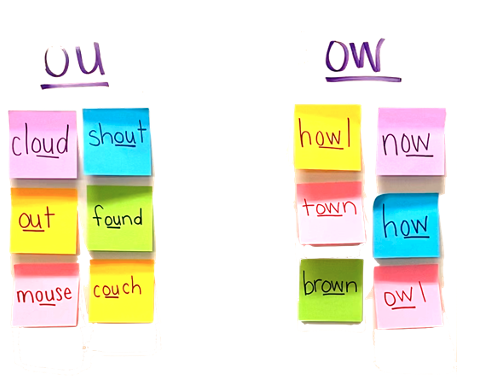
What Are Word Sorts?
Word sorts are a hands-on activity where students group words based on a specific pattern, grapheme, generalization, or sound. For example, students may sort words with the long /a/ sound into groups like ai, ay, and a_e or they may sort by word ending.
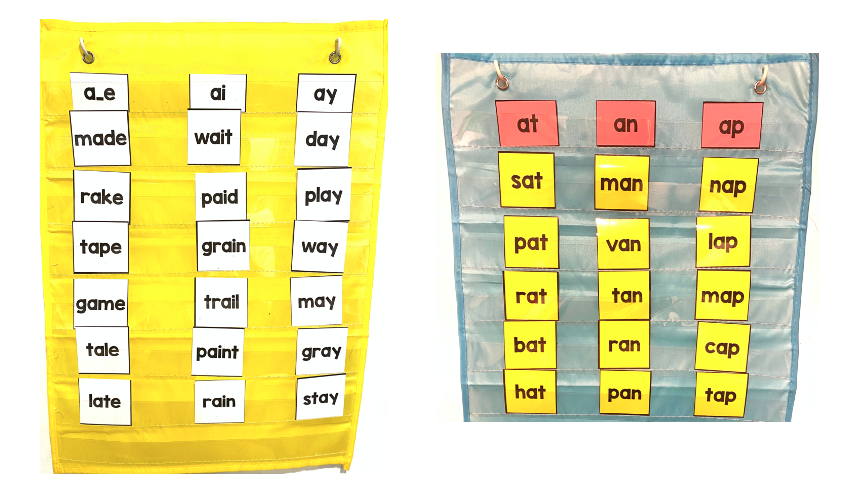
But word sorts are so much more than just matching. When used intentionally, they become a tool for building decoding skills and reinforcing patterns that students can carry into their reading and writing. When used effectively, they strengthen foundational literacy skills and set the stage for reading success.
Why Use Word Sorts in Phonics Instruction?
Here’s why word sorts should be a staple in your phonics instruction:
- Decoding Practice: Students practice reading words aloud, connecting graphemes to phonemes as they sort.
- Reinforcing grapheme to phoneme relationships: Once you have taught a new grapheme, word sorts a great way to reinforce the connection to its sound.
- Applying Generalizations: Sorting words helps students repeatedly see and apply phonics rules, making them more memorable.
- Encourages Pattern Recognition: By physically grouping words, students begin to notice patterns on their own.
The beauty of word sorts is that they help students see the patterns for themselves. Instead of just memorizing a rule, they’re uncovering it in the words they’re working with. It’s a great way to blend explicit teaching and discovery learning.
A criticism that word sorts get is that they are just matching letters. In some cases this can be true (if not used in a guided setting), but below I show examples of when that is not true. In each example, students must actually read the word to determine where to sort it. They also must apply phonics knowledge.
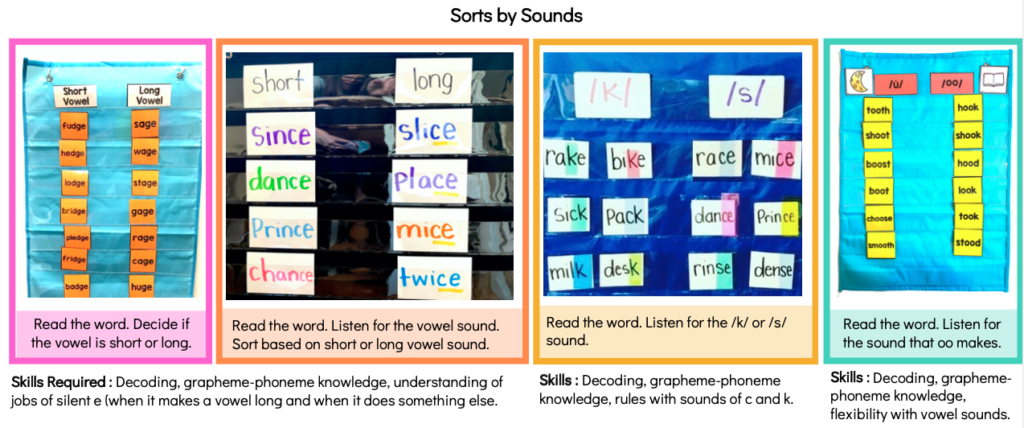
Steps to Effectively Use Word Sorts
Here’s how you can set up a word sort that packs a punch:
- Explicitly Teach the Rule, Grapheme, or Pattern: Before students begin, teach the phonics generalization, grapheme, or pattern. For example, explain when to use ck and when to use k at the end of words. We don’t want the learning to be left up to chance. We want to be intentional with our teaching.
- Prepare the Words: Provide students with a set of words that align with the phonics focus.
- Guide Students Through Decoding: This is a great opportunity to practice decoding. If you are working with a group of students, show the word card. Instruct them to quietly read the word to themselves so everyone is engaged and practicing the skill. Once everyone has read the word, read the word together.
- Sort the Word: Let students sort the words into columns or groups. This hands-on activity helps them actively process the new learning.
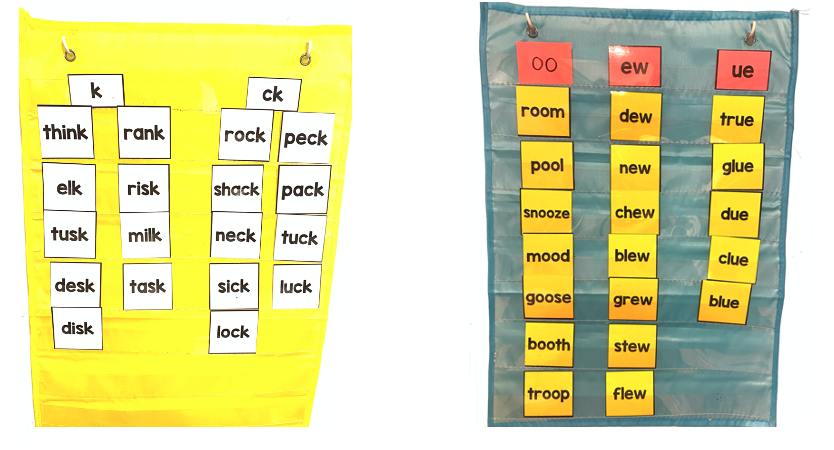
The picture above shows two different examples. The first shows the ck/k generalization. After sorting the words, you can reinforce again by pointing out the letters before the grapheme that spells /k/.
The second picture shows the sounds of long u. ew/ue are used at the end of words while oo is usually used in the middle. (oo can also be used at the beginning or end, but that is not as common.)I’ve done where I used a huge pocket chart and used all of the word cards. It showed how common oo is and how much more common ew is than ue. It was a helpful visual! All the while, they are getting decoding practice and getting a great visual to the ways to spell this sound.
Take It to the Next Level: Make Word Sorts More Interactive
The magic happens when students actively think about the patterns. Here’s how to make your sorts more interactive and effective:
- Ask Reflective Questions: After each word is sorted, ask:
- Why is that grapheme used to spell this sound?
- Where do you hear the (target sound)?
- Does this follow the rule?
- What did you notice about all the words in this column? (For example, in the first picture at the top of this post, they should notice ay is always at the end, while ai and a_e are in the middle.)
- Add this Step: After decoding and before sorting, have students repeat the word, close their eyes, and tap the sounds. This strengthens phonemic awareness. Then ask, Where do you hear the (target sound)? Then ask, Which letter(s) should spell that sound?
This process helps students connect the graphemes they see with the sounds they hear, deepening their understanding.
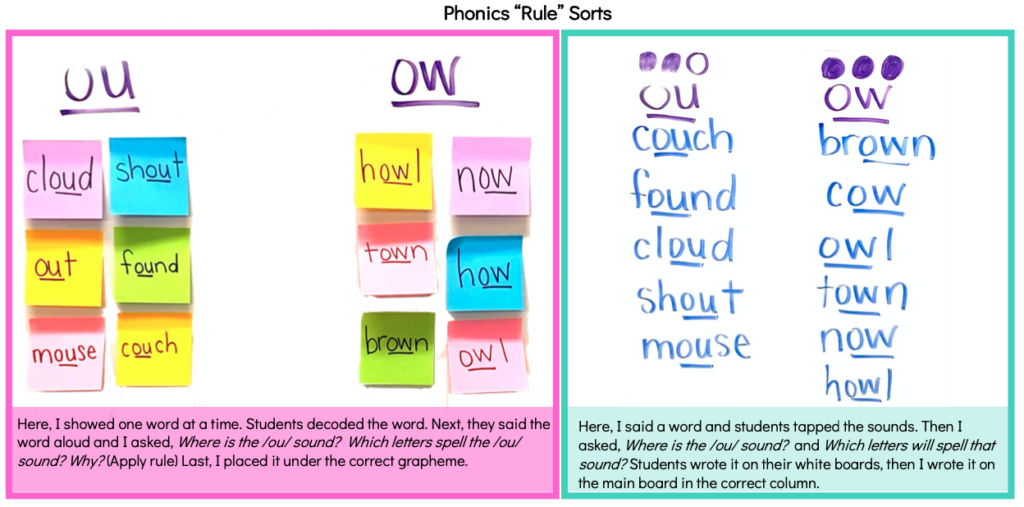
Why Leading Questions Matter
The key to making word sorts stick is repetition and reflection. When students answer questions like “Why is that grapheme used to spell this sound?” they’re solidifying the generalization. Over time, this becomes second nature.
Other Ideas for Word Sorts
These sorts each have a unique task. The first one is sorted by number of sounds. The second requires knowledge of the jobs of silent e. The third is focused on the patterns of the words. All of these sorts give students the opportunity to decode and apply phonics knowledge.
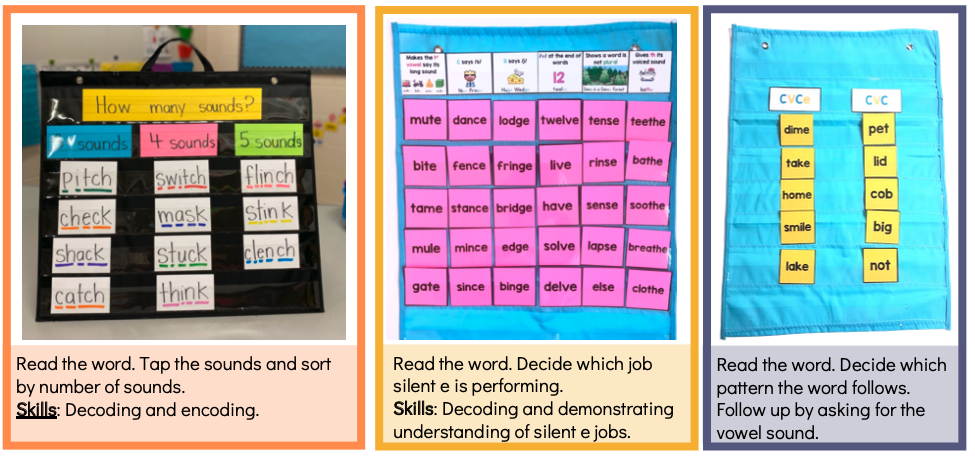
The sort below puts a fun twist on the word sort. The first letter is left out, so students have to apply the generalization for when to use k and when to use c at the beginning of words. Since both say /k/, they still get decoding practice, too.
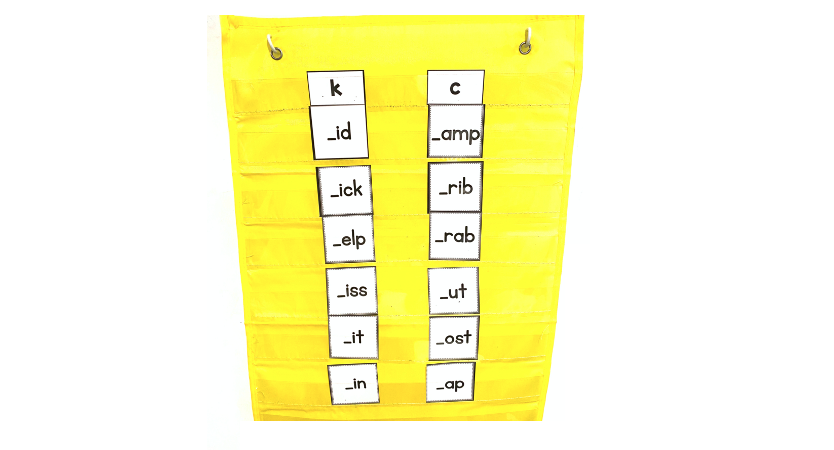
Using Word Sorts for Review
As you progress through your phonics scope and sequence, continuous review is essential to ensure mastery of previously taught skills. At the same time, you can integrate practice of new skills with review of older ones to reinforce learning and build connections.
For example, when teaching r-controlled vowels, a sorting activity with the headers Short Vowel, Long Vowel, and Bossy R can check understanding while reviewing older patterns. In my sequence, r-controlled vowels come right after long vowel teams (ai, ay, oa, ow, etc.). Before that is silent e. The sort below is a great way to practice decoding bossy r words while reviewing long vowels and short vowels.
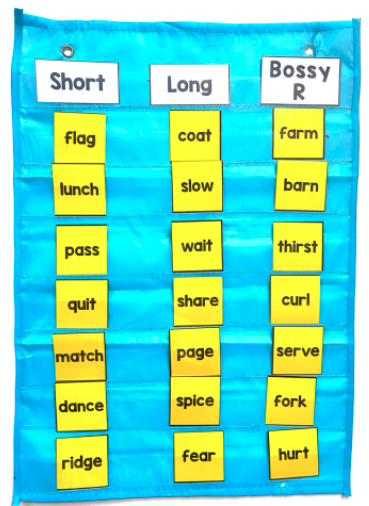
Find this sort here.
To reinforce an orthographic rule, I added “bridge” to highlight that short vowels always come before dge. I also added in “dance” to reinforce the both the <ce> grapheme and the “rule” that the vowel will usually only be long with the vowel-consonant-e pattern (not usually if there are two consonants between the vowel and the silent e.)
Ask students to explain their sorting to assess understanding and identify areas for additional support.
This approach not only checks for mastery of prior skills but also helps students connect and retain new learning.
Using Pictures for Phonemic Awareness and Spelling
Word sorts don’t just have to be with written words. Using pictures instead changes the focus and requires different skills. Picture sorts provide a unique twist that shifts the focus from decoding to encoding.
Here’s how it works:
- Show a Picture: Choose pictures representing words containing the target sound or rule. For example, a picture of a house and a cow could be used to focus on the short /ou/ sound.
- Repeat the Word: Say the word and have students repeat the word aloud.
- Tap the Sounds: Guide students to tap out the sounds in the word to isolate the target phoneme.
- Choose the Spelling: Students decide which grapheme spells the sound.
- If you are focusing on just matching the sound to the correct grapheme (as shown below), you will ask, What letter(s) spells this sound?

- If you are focusing on phonics “rules,” like the photos below, you would ask leading questions. For example, when sorting ai/ay or ou/ow, you would ask, Where do you hear the sound? This is because the spelling is dependent on where the sound is. When sorting tch/ch or dge/ge, you would ask, What comes right before that sound? This is because the spelling is dependent on the sound that comes before it.
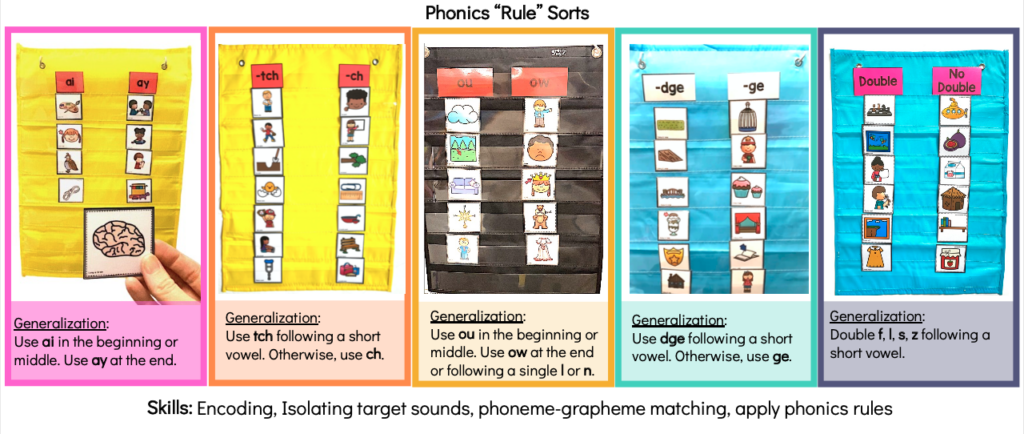
5. Once you have answered the leading questions, sort the word into the appropriate column. For more engagement, have students write the correct answer on their boards.
6. Optional: Follow up by having students spell the words on their white boards.
The following picture sorts do not focus on a generalization or grapheme, but rather on word endings. This requires students to segment onset and rhyme orally. Then, they are matching to the correct spelling of that rime. To loop in decoding, read the header cards between each picture card. That repetition will lead to automaticity.
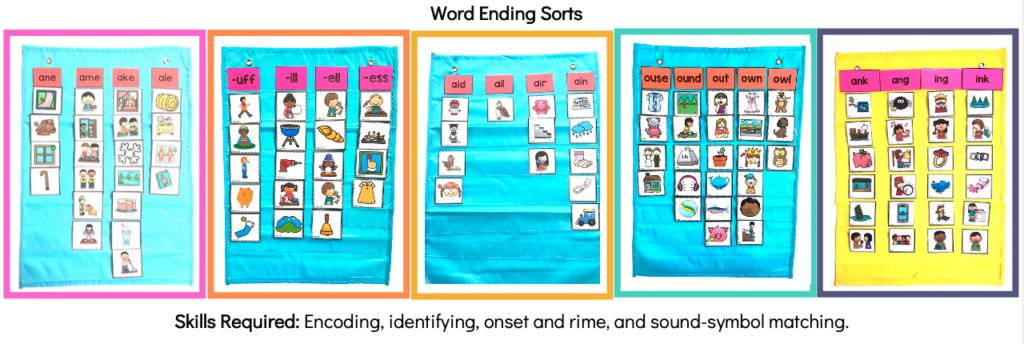
Word Sorts and Picture Sorts- What’s the Difference?
While word sorts focus on decoding, picture sorts emphasize encoding. This difference is key:
- Word Sorts: Students start with written words, decode them, and match them to the correct grapheme column. They are identifying patterns in words that are already spelled.
- Picture Sorts: Students start with a spoken word (based on a picture), tap out the sounds, and independently determine the correct grapheme to represent the target sound. This requires them to apply phonics generalizations from memory.
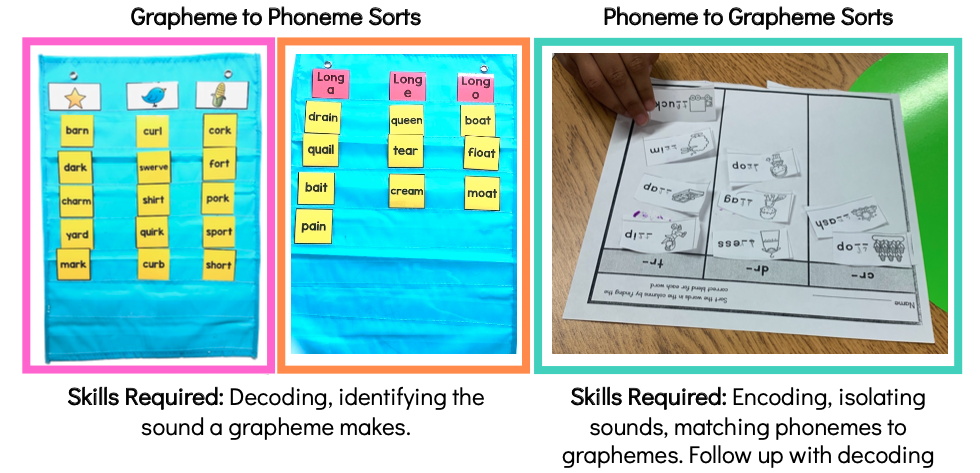
Picture sorts reinforce phonemic awareness and push students to think critically about spelling patterns. By requiring students to encode rather than decode, you’re helping them solidify their understanding of grapheme-phoneme relationships and build stronger spelling skills.
(Special shout-out to Learning a Latte in First for sharing that third picture with me!) Find the printable word sorts here.
Resources
If you’re looking to get started with word sorts, I’ve got you covered! Tap the link below to get to my Phonics Cards for sorts.
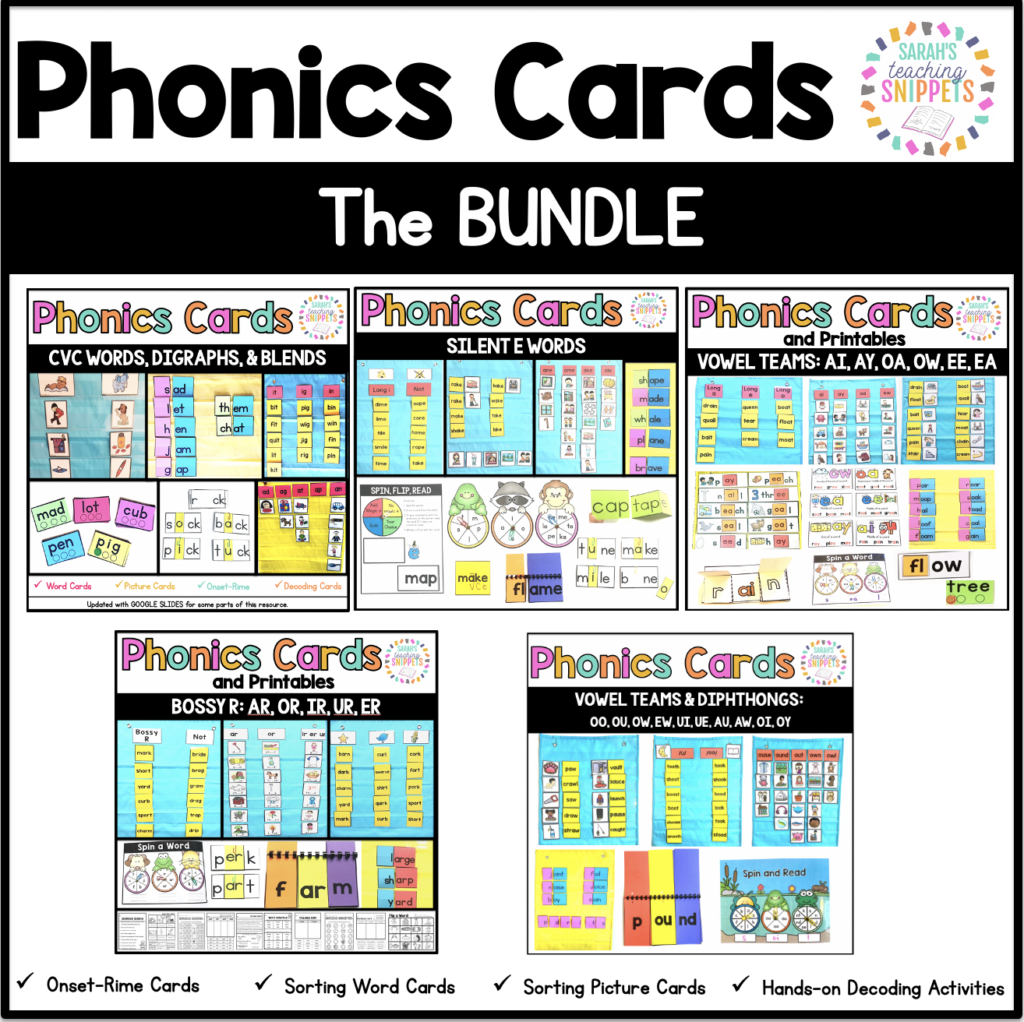
If laminating and cutting isn’t your jam, don’t worry! I have a “print-ready” option , too!
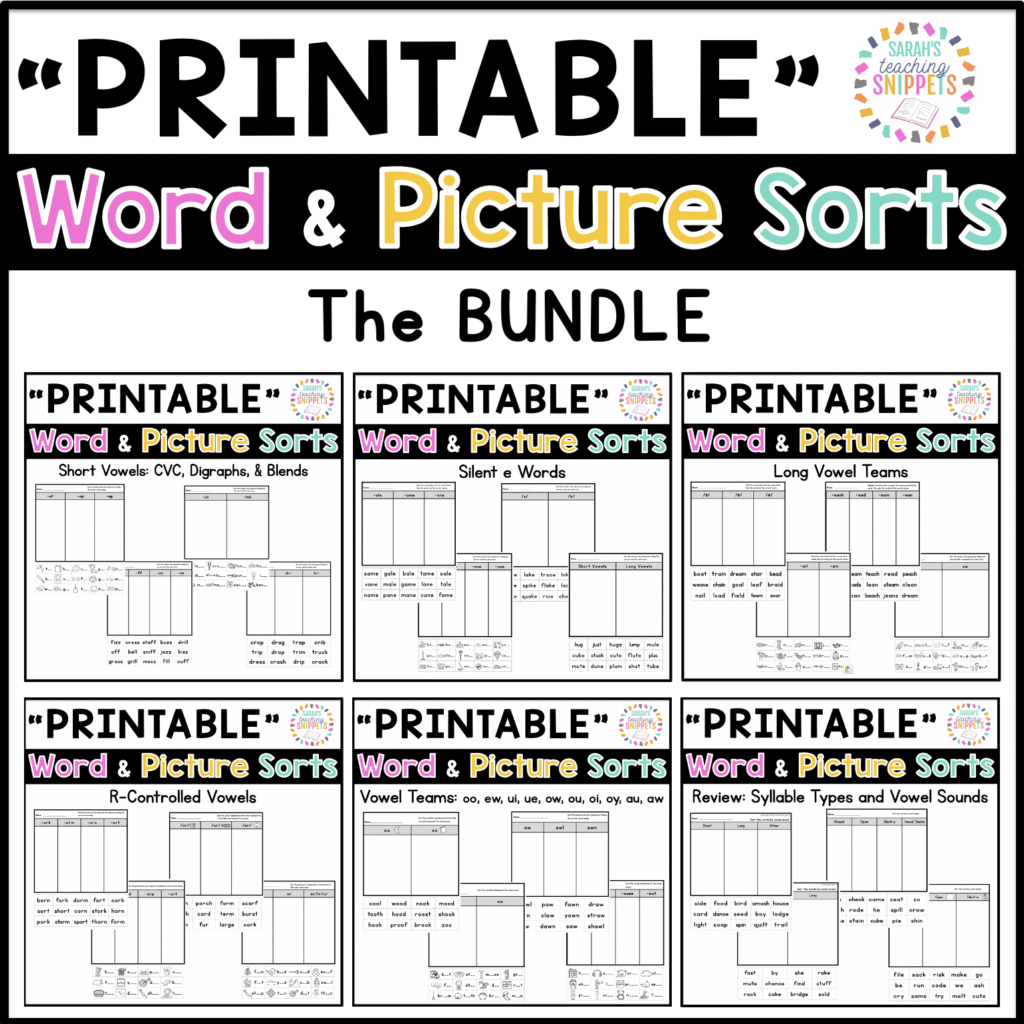
Have you tried word sorts in your classroom? Share your favorite tips or success stories in the comments below!









